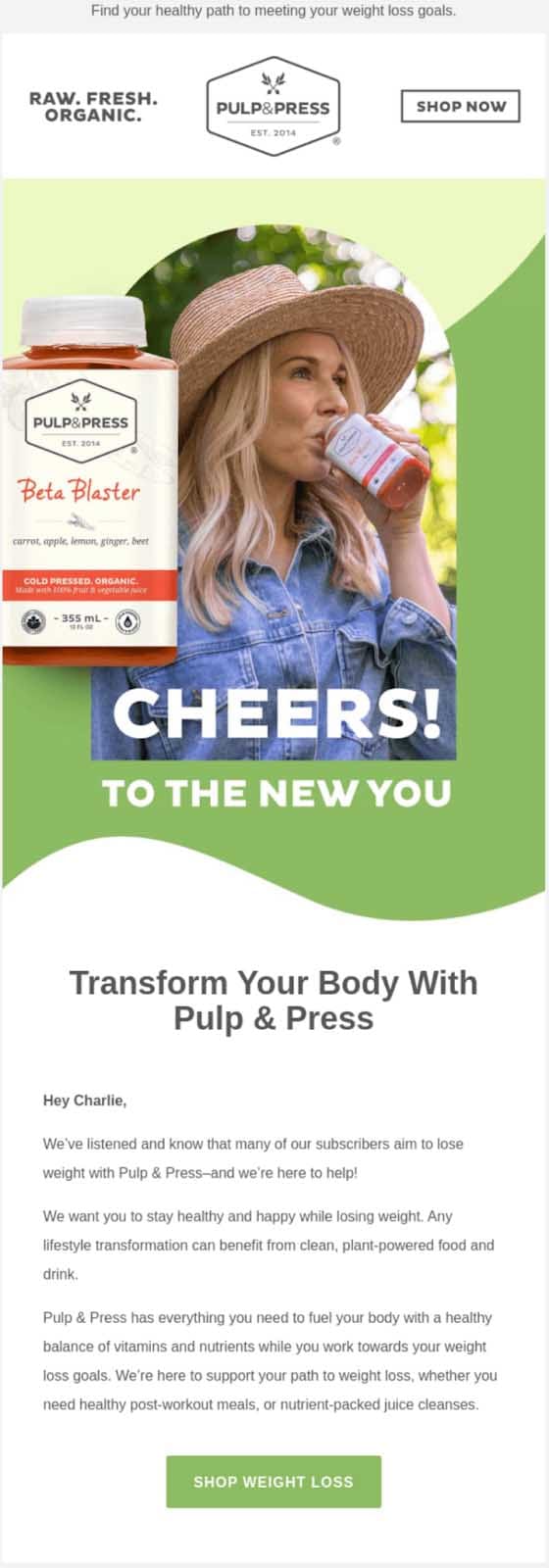You have an impressive email list that you’ve built over the years but are not sure what to do with it or you want to be ahead of the curve and learn how to drive action through email. In either case, email copywriting is the answer and the main reason why email marketing can net $36 for every $1 spent.
Email copywriting is a valuable skill that can be learned and honed over time through core principles, practice, and trial and error. In this article, we’ll cover:
- What exactly is email copywriting.
- What makes it so powerful.
- And the 7 best practices you can follow to write emails that resonate with your audience and generate sales.
Let’s begin.
What is Email Copywriting?
Copywriting is a form of writing that aims to inspire or guide readers to take a certain type of action such as clicking a link, making a sale, or taking further steps in a process.
Email copywriting focuses on driving such action through email and is involved in every step of crafting a marketing email, from the subject line down to the call-to-action.
Why Is Email Copywriting So Important?

Imagine you have a list of 2000 emails that all signed up through your website, meaning they are warm leads interested in your brand or in what you have to offer.
You broadcast a promotional email to your audience and lo and behold, the number of sales can be counted on one hand. The likely culprit for such an outcome? Perhaps an unattractive subject line, unclear email body, or everything in between.
Whatever the reason, you can likely blame it on bad email copy. So what would a good result look like for the size of your email list?
According to MailChimp, the average email open rate across all industries is around 21%. While it depends largely on your industry, a good email conversion rate falls between 2 and 5%.
Now let’s imagine you have an email campaign with world-class email copywriting. Your offer is:
- A $100 product.
- Your conversion rate is 4%.
That means out of 2000 people, 80 decided to make a purchase, netting you $8000 in revenue. If you had 10 times the number of emails, that would be 10 times the revenue, and so on.
How well your emails are prepared will decide how successful your campaigns will be, which is why email copywriting is such a powerful tool for marketers in driving revenue.
7 Best Email Copywriting Practices to Follow
You won’t become an email copywriting master overnight, but you can certainly become a much better one in the same timeframe with the right strategies in mind.
So without further ado, let’s see how you can get your emails to stand out, increase clicks, and drive conversions.
Captivate With Magnetic Subject Lines
Starting out, your subject line is the first point of interaction with your target audience and will be what determines whether your recipients click to learn more or move on.
Here are top data-backed ways to craft subject lines that get opened:
- Keep It Short and Simple
Over 50% of people use mobile devices to open emails, meaning your subject line only has around 60 characters before it cuts off. Short and catchy subject lines generally perform better than long ones, with the optimal length being around 40 – 45 characters long.
Be sure to preview how your emails look by sending test samples to yourself or using this tool to see them on different devices.
- Add Personalization
Simply adding your prospect’s name in the subject line can increase open rates by 26%. It’s easy to add names individually for a handful of contacts, but with large lists, email merge tools are the way to go.
For some industries like coaching, you can make your emails feel more person-to-person by having a welcoming profile picture and a name in your email address rather than a job title like [email protected].
- Build Curiosity
Having a question in your subject line can increase open rates by 21% while including a number can boost open rates to 113%.
Here are some simple ways to make a subject line more enticing:
- Mentioning a new statistic about your audience’s industry.
- Asking for their thoughts on something.
- Asking about a likely pain point your audience has.
Explain Benefits Over Features
When you have an awesome product or service, it’s easy to get overzealous listing its wide range of features. But the most important question that is lingering subconsciously in the minds of your readers is: “How does this benefit me?”
A list of features does not directly answer this crucial question, but describing benefits does.
For example, a fingerprint sensor is a feature of a new phone, but the benefit of such a feature is that customers can now unlock their phones faster. Benefits explain the value behind features.
Get Personal
We mentioned adding personalization in subject lines, but being personal in your email is key to driving sales. Let’s take a look at a highly personalized snippet of the following email:

They address the contact by name (likely with the help of mail merge tools) and use the pronoun forms “you” and “your” abundantly in the email.
This makes the outreach feel more personal and direct than an email with a robotic tone written with a large audience in mind instead of an individual.
Avoid Complex Words and Industry Jargon
Whether you are sending emails to industry professionals or to the common consumer, it’s always best to avoid sounding too sophisticated or wordy.
Retention is key to guiding your audience to your CTA (call-to-action), and using complex words and industry jargon is one easy way to get readers to break away. Focus instead on:
- Using simple, easy-to-understand words.
- Addressing pain points.
- Explaining benefits over features.
Inspire Action With Actionable Language
After all, that’s the main goal of email copywriting! A common mistake some emails fall into is simply sounding too boring. The language and overall tone fall flat and don't inspire action.

So what can you do to spice up your email copy? There’s no one-size-fits-all solution, but some great ways to inspire action in your emails are:
- Use more verbs and less adjectives.
When it comes to copywriting, verbs outperform adjectives because they help guide the reader to the desired outcome. Here is a great example from Crowd Content:
Bad: This beautiful necklace is perfect for your fashionable tastes.
Better: This necklace will satisfy the desires of the fashionista in you.
In the second sentence, “will satisfy” is a better and stronger choice than “is perfect”. One describes the necklace as perfect while the other boldly promises an outcome.
- Sell through storytelling
Humans love stories. Since the dawn of time to the modern day, storytelling remains an incredible way to quickly evoke curiosity, retain interest, and build an emotional connection no matter how small.
Stories don’t even have to directly be about the product or service you offer. When using stories to sell, any remote aspect of the story that can be connected to your pitch to make it relevant is enough reason to use one.
You can even make the story the main value in your email and the CTA the secondary value, almost like an extra.
Experiment for the Best Results
One beautiful aspect of email marketing is that there is plenty of room for experimenting to reach optimal results. A/B split testing is a powerful method that can help increase open rates by 49%.
To perform an A/B test for your subject lines, simply create two different subject lines for the same email and send each one to a separate group. The email that has the best performing open rate and engagement will have your winner subject line.
You can also A/B test your email copy by copywriting two different emails under the same subject line (ideally your winner subject line) and see which one leads to the best conversions.
Include A Clear CTA (Calls-To-Action)
Your email doesn’t need to be filled with CTAs from top to bottom in the hopes that one gets clicked. If you did a great job with your copywriting, then a simple CTA at the end will get the job done.
CTAs can be any variety of forms and buttons, often tied to the brand in creative ways. For example, check out this “Start for free” CTA that invites users to sign up for free (and enjoy a 14-day free trial!)
Key Takeaways
Good email copywriting is at the core of any successful email marketing campaign. It can make or break your outreach, but with the practices listed in this article in mind, you can now craft emails with an approach guaranteed to give you better results.
To wrap up, remember:
- Email copywriting covers every aspect of your email.
- Short and simple subject lines perform better than longer ones.
- Using actionable language and storytelling is a way to drive readers to take action.
- Use A/B split testing to reach the best-performing subject lines and emails.
- A clear, simple CTA is more than enough if your email copywriting is on point.





